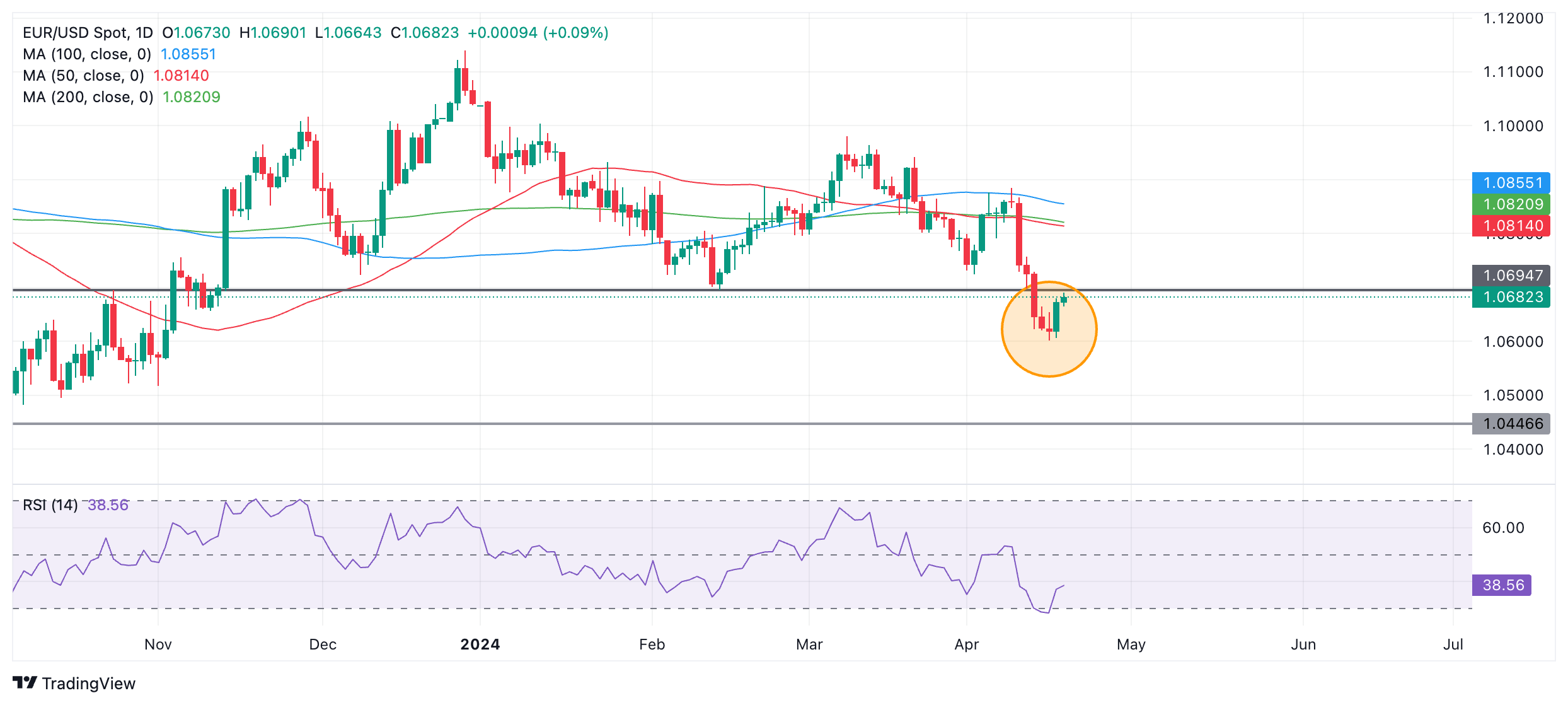- EUR/USD erases earlier gains after Banque de France chief says ECB should cut at next meeting.
- The pair had been recovering after Lagarde said “game is not over” with inflation.
- Slow economic growth and sticky inflation in the Eurozone could weigh on EUR/USD.
- Federal Reserve Chairman Powell talks about keeping rates higher for longer, and longer.
EUR/USD erases earlier gains and sinks into the 1.0640s on Thursday after Banque de France head and European Central Bank (ECB) policymaker Francois Villeroy de Galhau said, bar a major suprise “we should cut rates at the next meeting.”
The next meeting is in May and his comments indicate that he for one wishes to cut interest rates even before the June meeting currently earmarked as the time when most commentators expect the ECB to lower rates. Lower interest rates tend to depreciate a currency as they reduce foreign capital inflows.
De Galhau said there was a risk the ECB might be too late to stave off an economic slowdown if it waited too long before lowering interest rates.
“The risk would be to be behind the curve and to pay a too high cost in terms of economic activity,” he added.
EUR/USD rebound stalls
EUR/USD unwound earlier gains made on the back of comments by European Central Bank President Christine Lagarde, who said at a speech in Washington late on Wednesday that “The game (of fighting inflation) is not over,” despite adding, “Growth in Europe is mediocre, much slower than in the US. We’re clearly seeing timid signs of recovery.”
Lagarde’s comments introduced a smidgen of doubt into whether the ECB really will start cutting interest rates in June as markets believe.
Her remark about “Growth in Europe is mediocre,” echoes the view of Rabobank FX Strategists, who argue that whilst there is no risk of a “crisis” in the region, “ the combination of slow growth in the Eurozone and nagging budget pressures could lower the defenses of the EUR going forward.” Rabobank suggests a fall to 1.0500 is probable, with risks tilted to the downside.
EUR/USD pressured by talk of higher rates for longer in the US
EUR/USD plummeted at the start of April as bets the Federal Reserve (Fed) would cut interest rates in June quickly melted away amidst stickier-than-expected inflation and robust macroeconomic data.
On Tuesday, Federal Reserve Chairman Jerome Powell said high interest rates would likely be around for longer than previously expected given the little progress being made on inflation in recent months.
The Fed’s Beige Book, a comprehensive economic survey, on Tuesday repeated the view that little progress had been made on inflation but added that growth and employment were a little stronger than expected.
Everything points to the Fed maintaining interest rates at their relatively high (upper limit of 5.5% for the Fed Funds Rate) levels for a while until the behemoth of inflation is finally slain.
Indeed, The CME FedWatch tool, a market gauge of the probability of Fed rate cuts, is showing only a 16% probability of a cut in June (from over 70% only a few weeks ago) whilst the odds of a cut by September are now around 70%.
Technical Analysis: EUR/USD undertakes a youthful recovery
EUR/USD has undergone a volte-face after hitting a floor at 1.0601 on Tuesday (circled). The question now, as most technical questions are, is whether this is a reversal or just a pullback in an ongoing downtrend?
EUR / USD Daily Chart
Momentum has been strong in the short span of the recovery so far, and the Relative Strength Index (RSI) has moved out of oversold, giving a buy signal – another good sign. However, it is too early to draw conclusions.
The intermediate-term downtrend is probably still in force and in the absence of further proof of a reversal, likely to resume and push the exchange rate lower again.
Resistance from previous swing lows nearby at around 1.0700 could act as an obstacle to the recovery and see a rotation back down. The level will, in any case, offer technical resistance and provide a rallying point for bears even if their cause is doomed.
A break below the 1.0601 April lows would post a lower low and indicate a continuation of the downtrend. After that, the next concrete target is at 1.0446, the October 2023 low.
Algengar spurningar ECB
Seðlabanki Evrópu (ECB) í Frankfurt í Þýskalandi er varabanki evrusvæðisins. Seðlabanki Evrópu ákveður vexti og stjórnar peningamálastefnu fyrir svæðið. Meginvaldsvið ECB er að viðhalda verðstöðugleika, sem þýðir að halda verðbólgu í um 2%. Aðaltæki þess til að ná þessu er með því að hækka eða lækka vexti. Tiltölulega háir vextir munu venjulega leiða til sterkari evru og öfugt. Bankaráð ECB tekur ákvarðanir um peningastefnu á fundum sem haldnir eru átta sinnum á ári. Ákvarðanir eru teknar af forstöðumönnum landsbanka evrusvæðisins og sex fastráðnum meðlimum, þar á meðal forseta ECB, Christine Lagarde.
Í öfgafullum aðstæðum getur Seðlabanki Evrópu sett stefnumótun sem kallast Magnbundin íhlutun. QE er ferlið þar sem ECB prentar evrur og notar þær til að kaupa eignir - venjulega ríkis- eða fyrirtækjaskuldabréf - frá bönkum og öðrum fjármálastofnunum. QE leiðir venjulega til veikari evru. QE er síðasta úrræði þegar það að lækka vexti er ólíklegt til að ná markmiðinu um verðstöðugleika. ECB notaði það í fjármálakreppunni miklu á árunum 2009-11, árið 2015 þegar verðbólga hélst þrjóskandi lág, sem og meðan á Covid-faraldrinum stóð.
Magnbundin þrenging (QT) er andstæða QE. Það er gert eftir QE þegar efnahagsbati er í gangi og verðbólga fer að aukast. Á meðan í QE kaupir Evrópski seðlabankinn (ECB) ríkis- og fyrirtækjaskuldabréf af fjármálastofnunum til að sjá þeim fyrir lausafé, í QT hættir ECB að kaupa fleiri skuldabréf og hættir að endurfjárfesta höfuðstólinn sem er á gjalddaga á þeim skuldabréfum sem hann á nú þegar. Það er venjulega jákvætt (eða bullish) fyrir evruna.
Source: https://www.fxstreet.com/news/eur-usd-executes-u-turn-after-lagardes-hawkish-comments-202404180802

